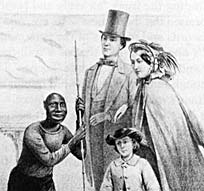The What Is It? ExhibitThe Lost Museum Archive

In February 1860, just three months after Charles Darwin published Origin of Species, Barnum premiered one of his most famous exhibits, "What Is It?" Claiming that the African American performer playing What Is It? was a possible missing link between man and beast, Barnum merged supposedly objective scientific findings about evolution with ongoing antebellum debates over racial definition, the morality of slavery, and sectional politics. The exhibit opened during the 1860 Presidential campaign, which revolved around issues of slavery and the rights and definition of African Americans as citizens. Advertisements and promotional material for What Is It? labeled the exhibit a "nondescript" and invited the public to answer the question for themselves. While What Is It? was defined as racially, socially and biologically lower than its viewers, Barnum and newspaper reviewers emphasized the "pleasing" and "playful" nature of the exhibit. As James Cook argues in The Arts of Deception, the ambiguity of the exhibit— was it a beast or a playful child — reflected the tentativeness of middle-class formation and social order in antebellum America.